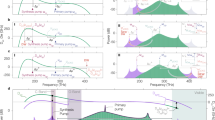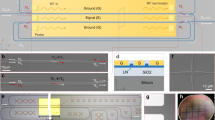Abstract
Optical frequency combs consist of equally spaced discrete optical frequency components and are essential tools for optical communication, precision metrology, timing and spectroscopy1,2,3,4,5,6,7,8,9. At present, combs with wide spectra are usually generated by mode-locked lasers10 or dispersion-engineered resonators with third-order Kerr nonlinearity11. An alternative method of comb production uses electro-optic (EO) phase modulation in a resonator with strong second-order nonlinearity, resulting in combs with excellent stability and controllability12,13,14. Previous EO combs, however, have been limited to narrow widths by a weak EO interaction strength and a lack of dispersion engineering in free-space systems. Here we overcome these limitations by realizing an integrated EO comb generator in a thin-film lithium niobate photonic platform that features a large EO response, ultralow optical loss and highly co-localized microwave and optical fields15, while enabling dispersion engineering. Our measured EO comb spans more frequencies than the entire telecommunications L-band (over 900 comb lines spaced about 10 gigahertz apart), and we show that future dispersion engineering can enable octave-spanning combs. Furthermore, we demonstrate the high tolerance of our comb generator to modulation frequency detuning, with frequency spacing finely controllable over seven orders of magnitude (10 hertz to 100 megahertz), and we use this feature to generate dual-frequency combs in a single resonator. Our results show that integrated EO comb generators are capable of generating wide and stable comb spectra. Their excellent reconfigurability is a powerful complement to integrated Kerr combs, enabling applications ranging from spectroscopy16 to optical communications8.
This is a preview of subscription content, access via your institution
Access options
Access Nature and 54 other Nature Portfolio journals
Get Nature+, our best-value online-access subscription
$29.99 / 30 days
cancel any time
Subscribe to this journal
Receive 51 print issues and online access
$199.00 per year
only $3.90 per issue
Buy this article
- Purchase on Springer Link
- Instant access to full article PDF
Prices may be subject to local taxes which are calculated during checkout




Similar content being viewed by others
Data availability
The datasets generated and analysed during the current study are available from the corresponding authors on reasonable request.
References
Ye, J., Schnatz, H. & Hollberg, L. W. Optical frequency combs: from frequency metrology to optical phase control. IEEE J. Sel. Top. Quantum Electron. 9, 1041–1058 (2003).
Papp, S. B. et al. Microresonator frequency comb optical clock. Optica 1, 10–14 (2014).
Coddington, I., Newbury, N. & Swann, W. Dual-comb spectroscopy. Optica 3, 414–426 (2016).
Bernhardt, B. et al. Cavity-enhanced dual-comb spectroscopy. Nat. Photon. 4, 55–57 (2010).
Dutt, A. et al. On-chip dual-comb source for spectroscopy. Sci. Adv. 4, e1701858 (2018).
Suh, M.-G., Yang, Q.-F., Yang, K. Y., Yi, X. & Vahala, K. J. Microresonator soliton dual-comb spectroscopy. Science 354, 600–603 (2016).
Trocha, P. et al. Ultrafast optical ranging using microresonator soliton frequency combs. Science 359, 887–891 (2018).
Pfeifle, J. et al. Coherent terabit communications with microresonator Kerr frequency combs. Nat. Photon. 8, 375–380 (2014).
Suh, M.-G. & Vahala, K. J. Soliton microcomb range measurement. Science 359, 884–887 (2018).
Cundiff, S. T., Ye, J. & Hall, J. L. Optical frequency synthesis based on mode-locked lasers. Rev. Sci. Instrum. 72, 3749–3771 (2001).
Kippenberg, T. J., Gaeta, A. L., Lipson, M. & Gorodetsky, M. L. Dissipative Kerr solitons in optical microresonators. Science 361, eaan8083 (2018).
Kourogi, M., Nakagawa, K. & Ohtsu, M. Wide-span optical frequency comb generator for accurate optical frequency difference measurement. IEEE J. Quantum Electron. 29, 2693–2701 (1993).
Beha, K. et al. Electronic synthesis of light. Optica 4, 406–411 (2017).
Xiao, S., Hollberg, L., Newbury, N. R. & Diddams, S. A. Toward a low-jitter 10 GHz pulsed source with an optical frequency comb generator. Opt. Express 16, 8498–8508 (2008).
Wang, C. et al. Integrated lithium niobate electro-optic modulators operating at CMOS-compatible voltages. Nature 562, 101–104 (2018).
Millot, G. et al. Frequency-agile dual-comb spectroscopy. Nat. Photon. 10, 27–30 (2016).
Del’Haye, P. et al. Octave spanning tunable frequency comb from a microresonator. Phys. Rev. Lett. 107, 063901 (2011).
Okawachi, Y. et al. Octave-spanning frequency comb generation in a silicon nitride chip. Opt. Lett. 36, 3398–3400 (2011).
Griffith, A. G. et al. Silicon-chip mid-infrared frequency comb generation. Nat. Commun. 6, 6299 (2015).
Savchenkov, A. A. et al. Tunable optical frequency comb with a crystalline whispering gallery mode resonator. Phys. Rev. Lett. 101, 093902 (2008).
Liang, W. et al. Generation of near-infrared frequency combs from a MgF2 whispering gallery mode resonator. Opt. Lett. 36, 2290–2292 (2011).
Gräupner, P., Pommier, J. C., Cachard, A. & Coutaz, J. L. Electro-optical effect in aluminum nitride waveguides. J. Appl. Phys. 71, 4136–4139 (1992).
Herr, T. et al. Universal formation dynamics and noise of Kerr-frequency combs in microresonators. Nat. Photon. 6, 480–487 (2012).
Yi, X. et al. Single-mode dispersive waves and soliton microcomb dynamics. Nat. Commun. 8, 14869 (2017).
Metcalf, A. J., Torres-Company, V., Leaird, D. E. & Weiner, A. M. High-power broadly tunable electrooptic frequency comb generator. IEEE J. Sel. Top. Quantum Electron. 19, 231–236 (2013).
Sakamoto, T., Kawanishi, T. & Izutsu, M. Asymptotic formalism for ultraflat optical frequency comb generation using a Mach-Zehnder modulator. Opt. Lett. 32, 1515–1517 (2007).
Ozharar, S., Quinlan, F., Ozdur, I., Gee, S. & Delfyett, P. J. Ultraflat optical comb generation by phase-only modulation of continuous-wave light. IEEE Photonics Technol. Lett. 20, 36–38 (2008).
Ho, K. P. & Kahn, J. M. Optical frequency comb generator using phase modulation in amplified circulating loop. IEEE Photonics Technol. Lett. 5, 721–725 (1993).
Kourogi, M., Widiyatomoko, B., Takeuchi, Y. & Ohtsu, M. Limit of optical-frequency comb generation due to material dispersion. IEEE J. Quantum Electron. 31, 2120–2126 (1995).
Dupuis, N. et al. InP-based comb generator for optical OFDM. J. Lightwave Technol. 30, 466–472 (2012).
Demirtzioglou, I. et al. Frequency comb generation in a silicon ring resonator modulator. Opt. Express 26, 790–796 (2018).
Kim, J., Richardson, D. J. & Slavík, R. Cavity-induced phase noise suppression in a Fabry–Perot modulator-based optical frequency comb. Opt. Lett. 42, 1536–1539 (2017).
Kourogi, M., Enami, T. & Ohtsu, M. A coupled-cavity monolithic optical frequency comb generator. IEEE Photonics Technol. Lett. 8, 1698–1700 (1996).
Zhang, M., Wang, C., Cheng, R., Shams-Ansari, A. & Lončar, M. Monolithic ultra-high-Q lithium niobate microring resonator. Optica 4, 1536–1537 (2017).
Wang, C., Zhang, M., Stern, B., Lipson, M. & Lončar, M. Nanophotonic lithium niobate electro-optic modulators. Opt. Express 26, 1547–1555 (2018).
Kobayashi, T., Sueta, T., Cho, Y. & Matsuo, Y. High-repetition-rate optical pulse generator using a Fabry–Perot electro-optic modulator. Appl. Phys. Lett. 21, 341–343 (1972).
Saitoh, T. et al. Modulation characteristic of waveguide-type optical frequency comb generator. J. Lightwave Technol. 16, 824–832 (1998).
Kim, J., Richardson, D. J. & Slavík, R. In 2016 IEEE Photonics Conference (IPC) 503–504, https://doi.org/10.1109/IPCon.2016.7831201 (2016).
Acknowledgements
This work is supported by the National Science Foundation (award numbers ECCS-1609549, ECCS-1740291 E2CDA, ECCS-1740296 E2CDA and DMR-1231319); the Harvard University Office of Technology Development (Physical Sciences and Engineering Accelerator Award); and Facebook, Inc. Device fabrication is performed at the Harvard University Center for Nanoscale Systems, a member of the National Nanotechnology Coordinated Infrastructure Network, which is supported by the National Science Foundation (award number ECCS-1541959).
Reviewer information
Nature thanks Yanne K. Chembo, Paulina Kuo and the other anonymous reviewer(s) for their contribution to the peer review of this work.
Author information
Authors and Affiliations
Contributions
M.Z., B.B., C.W., J.M.K. and M.L. conceived the experiment. M.Z., C.W. and A.S.-A. designed and fabricated the devices. B.B. performed theoretical modelling and numerical simulations of the integrated EO comb. M.Z. and R.Z. designed waveguide dispersion. M.Z., C.W., A.S.-A. and C.R. carried out the device characterization. M.Z. and B.B. performed the data analysis. M.Z. and B.B. wrote the manuscript with contributions from all authors. J.M.K. and M.L. supervised the project.
Corresponding authors
Ethics declarations
Competing interests
The authors declare competing interests: M.Z., C.W., C.R. and M.L. are involved in developing lithium niobate technologies at HyperLight Corporation.
Additional information
Publisher’s note: Springer Nature remains neutral with regard to jurisdictional claims in published maps and institutional affiliations.
Extended data figures and tables
Extended Data Fig. 1 Dispersion engineering and tailored EO comb phase-matching condition.
a, Simulated dispersion for an air-clad lithium niobate ridge waveguide with top width w = 1,800 nm, film thickness t = 600 nm and etch depth h = 550 nm. b, The phase-matching condition for generating EO comb sidebands. The grey area shows the region of phase matching, with round-trip modulation strength β. With a 50-GHz microwave drive and β = 1.2π, an EO comb spanning 1.3 octaves can be generated. c, Simulated group velocity dispersion (GVD) for an air-clad lithium niobate waveguide with a different geometry optimized for an octave-spanning comb with small microwave driving amplitude. d, An octave-spanning EO comb is shown with β = 0.3π. e, Another example of an air-clad lithium niobate waveguide with dispersion engineered for broad comb generation. f, Such EO comb generation features a flat response over 600 nm. A broad comb spanning less than an octave can be generated in devices with small microwave modulation amplitudes and high-Q optical resonators.
Rights and permissions
About this article
Cite this article
Zhang, M., Buscaino, B., Wang, C. et al. Broadband electro-optic frequency comb generation in a lithium niobate microring resonator. Nature 568, 373–377 (2019). https://doi.org/10.1038/s41586-019-1008-7
Received:
Accepted:
Published:
Issue Date:
DOI: https://doi.org/10.1038/s41586-019-1008-7
This article is cited by
-
Agile THz-range spectral multiplication of frequency combs using a multi-wavelength laser
Nature Communications (2024)
-
Passive frequency comb generation at radiofrequency for ranging applications
Nature Communications (2024)
-
Thin-film lithium niobate electro-optic terahertz wave detector
Scientific Reports (2024)
-
Adapted poling to break the nonlinear efficiency limit in nanophotonic lithium niobate waveguides
Nature Nanotechnology (2024)
-
Integrated frequency-modulated optical parametric oscillator
Nature (2024)
Comments
By submitting a comment you agree to abide by our Terms and Community Guidelines. If you find something abusive or that does not comply with our terms or guidelines please flag it as inappropriate.



